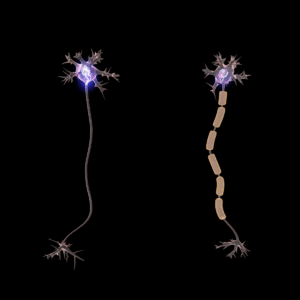Nervous tissue facts for kids
Nervous tissue is a special kind of material that makes up your nervous system. This includes your brain, spinal cord, and all the nerves throughout your body. It's like the body's super-fast communication network! This tissue helps control everything you do, from thinking and feeling to moving and breathing.
Nervous tissue is mostly made of two main types of cells: neurons and neuroglia cells. Neurons are the messengers; they send electrical signals called impulses. Neuroglia cells are the helpers; they support neurons, give them food, and even help speed up those electrical messages.
Contents
What is Nervous Tissue?
Nervous tissue is the main part of your nervous system. Think of it as the control center and communication lines for your entire body. It allows different parts of your body to talk to each other very quickly. This amazing tissue helps you react to the world around you. It also controls your body's internal functions, like your heartbeat and digestion.
The Amazing Neuron
Neurons are the basic building blocks of your nervous system. They are special cells designed to send and receive information. Each neuron can send tiny electrical signals, like miniature lightning bolts, from one part of your body to another. These signals are called nerve impulses. They travel incredibly fast, allowing you to react in a flash.
How Neurons Send Messages
Neurons send messages using electrical and chemical signals. When a neuron gets a signal, it creates an electrical impulse. This impulse travels along the neuron's long arm, called an axon. When it reaches the end, it releases special chemicals. These chemicals then jump to the next neuron, passing the message along. This process happens millions of times every second!
Parts of a Neuron
A typical neuron has three main parts. The cell body is like the neuron's brain; it contains the nucleus and keeps the cell alive. Dendrites are like tiny branches that stick out from the cell body. They are responsible for receiving signals from other neurons. The axon is a long, thin fiber that carries signals away from the cell body. Some axons are covered in a fatty layer called myelin. This myelin helps the electrical signals travel even faster.
Glial Cells: Neurons' Helpers
While neurons are the stars of the show, glial cells are their essential support crew. Glial cells do not send electrical impulses themselves. Instead, they perform many vital tasks to keep neurons healthy and working well. They provide nutrients to neurons and clean up waste. Some glial cells also form the myelin sheath around axons, which helps speed up nerve impulses. Without glial cells, neurons couldn't do their job properly.
Why is Nervous Tissue Important?
Nervous tissue is incredibly important for almost everything your body does. It allows you to think, learn, and remember. It helps you feel sensations like touch, pain, heat, and cold. It also controls your muscles, allowing you to move, speak, and even blink. Your nervous tissue also manages automatic body functions. These include your breathing, heart rate, and digestion. It's truly the master controller of your body!
See also
 In Spanish: Tejido nervioso para niños
In Spanish: Tejido nervioso para niños


